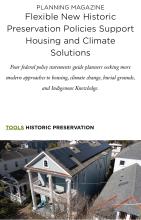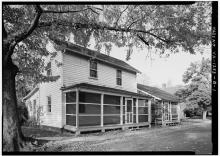The ACHP is now recruiting for the position of Director of the Office of Tribal and Indigenous Peoples (OTIP) in Washington, D.C. The OTIP Director is a critical senior management position within the ACHP that reports to the executive director and operates under his general supervision. Long recognized as a government-wide leader in advancing and improving the engagement of Indian Tribes, Native Hawaiian organizations (NHOs), and other Indigenous Peoples in the historic preservation program, the OTIP Director plays a critical role in the following areas:
News
On May 9, Planning Magazine published Chair Sara C. Bronin’s overview of ACHP’s recent work to support more modern approaches to housing, climate change, burial grounds and human remains, and Indigenous Knowledge. The Advisory Council’s four new policy statements are intended to guide decision-makers at all levels of government and professionals in private practice.
The four policy statements address the following important and timely topics:
Join ACHP Chair Sara C. Bronin at 5 p.m. CT on Tuesday, July 23, 2024 at Northwestern Pritzker School of Law for a discussion of federal preservation law and policy, including new ACHP initiatives on housing and climate change, and specific government actions involving Chicago's historic resources.
The meeting is open to the public and will take place in Lincoln Hall, Room LM104, 357 E. Chicago Ave., Chicago, IL.
WASHINGTON, DC — Advisory Council on Historic Preservation (ACHP) members voted on May 17 to approve the issuance of a program comment that provides the Department of the Army with an alternate way to comply with its responsibilities under Section 106 of the National Historic Preservation Act (NHPA). This program comment specifically addresses the Army’s inventory of housing constructed on Army installations nationwide prior to 1919 and covers 867 homes located on 19 installations in 14 states.
Today, The Hill published ACHP Chair Sara Bronin’s op-ed which calls for modernizing federal historic preservation standards to meet today’s pressing needs.
Bronin writes: “At their best, these standards help preserve the historic buildings, homes, schools, and places of worship that form the soul of our communities. But when applied too rigidly and without regard to the needs of communities, they become yet another source of red tape and an obstacle in efforts to expand housing, retrofit buildings for climate change, and spur economic growth.”

